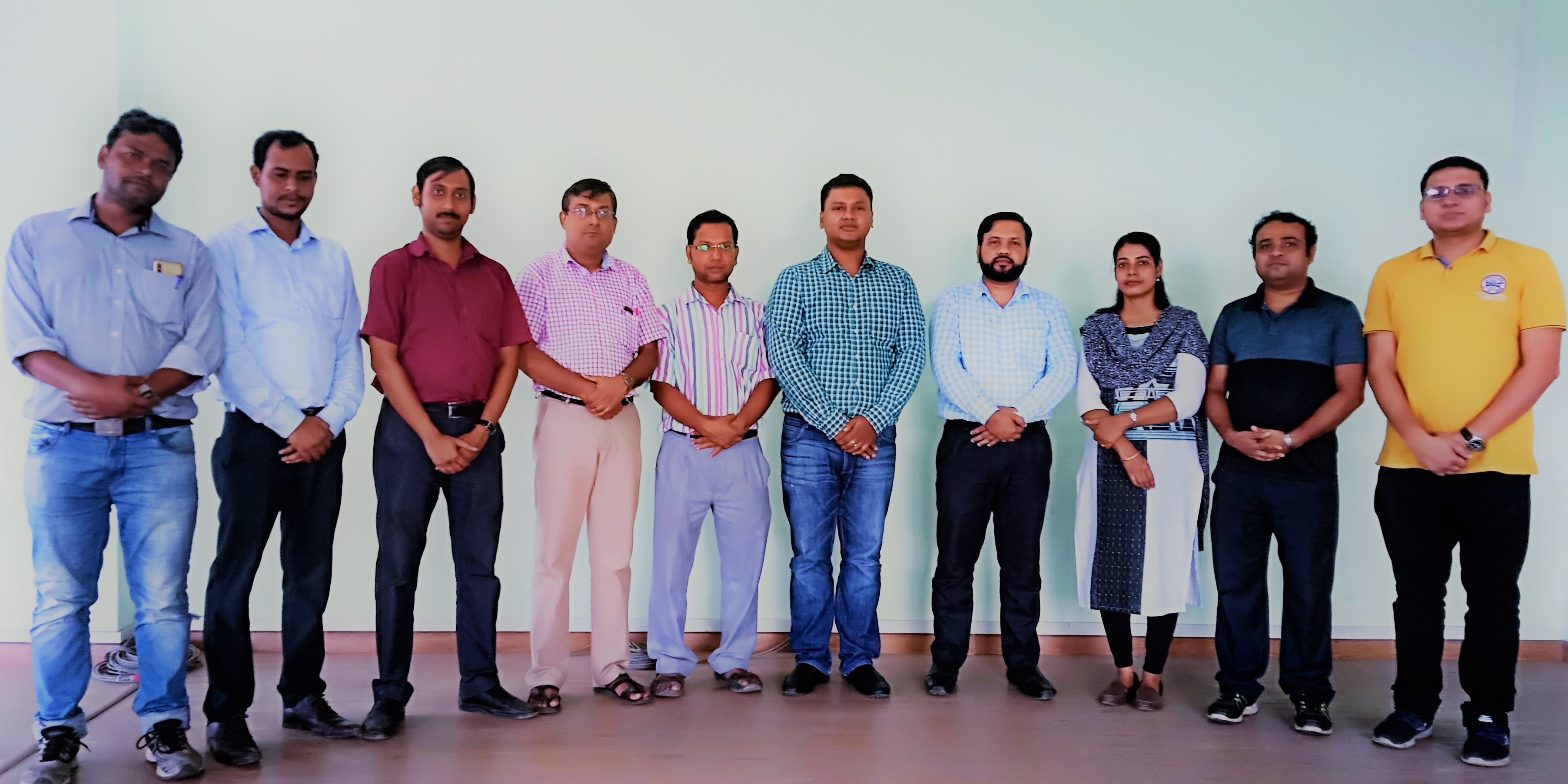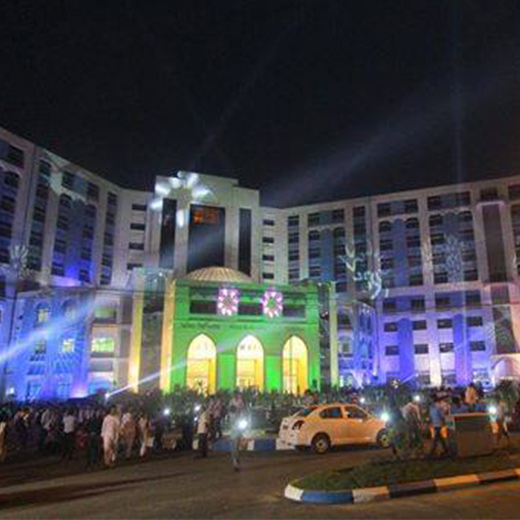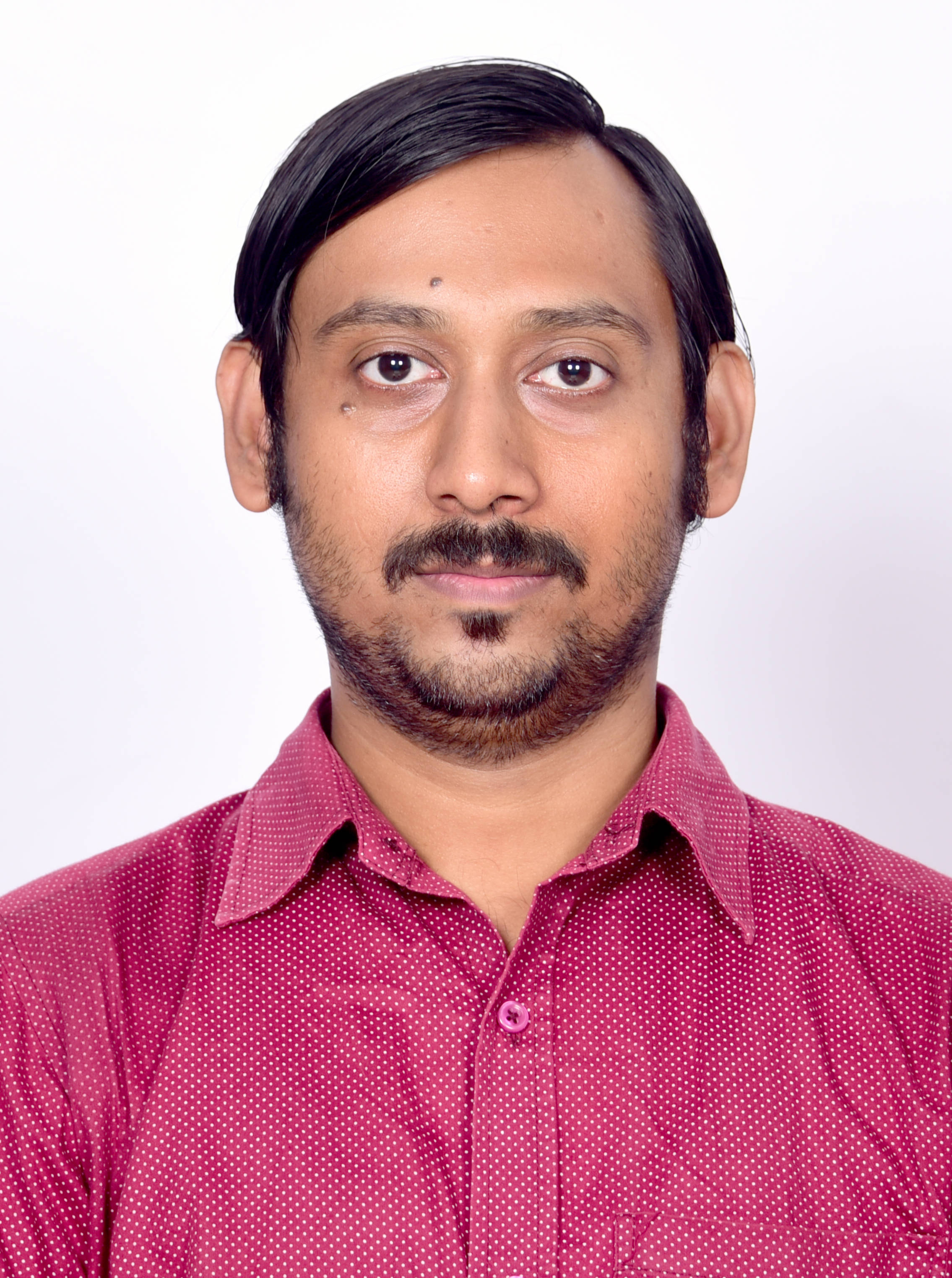


Email : sumanta.ray@aliah.ac.in
Address :
Joined : 11.11.2013
Assistant Professor,
Department of Computer Science and Engineering,
New Town, Kolkata-700156
Assistant Professor in the Department of Computer Science and Engineering, Aliah University, Kolkata-700156 (Current Position)
Dr. Sumanta Ray is currently Assistant Professor in the Department of Computer Science and Engineering in Aliah University, Kolkata. He did his B.Tech from Kalyani Government Engineering College, West Bengal and M.Tech from University of Kalyani in 2009 and 2012 respectively. He obtained his Ph.D (Engg.) in Computer Science from Jadavpur University in 2017. During his M.Tech he secured first rank in the University. He is the recipient of DST Inspire Fellowship Govt. of India. He also received Senior Research Fellowship of CSIR (Council of Scientific and Industrial Research), MHRD, Govt. of India. He previously served as a Junior Research Fellow in a Swarna Jayanti Project at Indian Statistical Institute during 2012-2013. He worked as Postdoctoral Fellow on ERCIM (European Research Consortium for Informatics and Mathematics) programme at CENTRUM WISKUNDE & INFORMATICA (CWI), The Netherlands during 2019-20120. His research interest includes Bioinformatics, Soft and Evolutionary Computing, Multiobjective Optimization, Deep Learning and Pattern Recognition.
Academic Experiences
Administrative Experience:
15. S. Ray, S Lall, A Mukhopadhyay, S Bandyopadhyay and A Sch¨onhuth, Deep variational graph autoencoders for novel host-directed therapy options against COVID-19, 29th Conference on Intelligent Systems in Molecular Biology ISMB/ECCB 2021, COVID-19 special track.
14. SM. Hossain, S. Ray* and A. Mukhopadhyay, “Detecting Overlapping Gene Communities during Stomach Adenocarcinoma: A Discrete NMF-based Integrative Approach”, 2020 IEEE International Conference on Advent Trends in Multidisciplinary Research and Innovation (ICATMRI), p:1-6), (2021).
13. S. Lall, S. Ray* and S. Bandyopadhyay, “Identifying novel SARS-CoV2–human protein interactions using graph embedding”, 28th Conference on Intelligent Systems in Molecular Biology (ISMB-2020, COVID-19 special track), Accepted (2020).
12. SM. Hossain, A. Mukhopadhyay and S. Ray*, “Detecting hub genes and key modules in stomach adenocarcinoma using nsNMF based data integration technique”, IEEE 18th International Conference on Information Technology, Accepted (2019).
11. D. Bhattacharjee, SM. Hossain, R. Sultana and S. Ray*, “Topological Inquisition into the PPI Networks Associated with Human Diseases Through Graphlet Frequency Distribution”, Pattern Recognition and Machine Intelligence. PReMI 2017, volume 10597:431-437 (2017).
10. SM Hossain, S. Ray, TS Tannee and A. Mukhopadhyay , “Analyzing Prognosis Characteristics of Hepatitis C using a Biclustering Based Approach Number”, 7th International Conference on Advances in Computing and Communications (ICACC-20170), Vol:215, pp-282-289 (2017).
9. SA. Khan and S. Ray*, “Integrating multi-view data: A hypergraph based approach”, First International Conference on Computational Intelligence, Communications, and Business Analytics (CICBA-2017), Vol:776, 347-357 (2017).
8. S. Ray, SM. Hossain and L. Khatun, “Discovering preservation pattern from co-expression modules in progression of HIV-1 disease: An eigengene based approach”, International Conference on Advances in Computing, Communications and Informatics (ICACCI2016), DOI: 10.1109/ICACCI.2016.7732146 (2016).
7. SM. Hossain, Z. Mahboob, R. Chowdhury, A. Sohel and S. Ray*, “Protein complex detection in PPI network by identifying mutually exclusive proteinprotein interactions”, In 6h International Conference on Advances in Computing and Communications (ICACC-2016), Volume 93, pp-1054-1060 (2016).
6. S. Ray, A. Hossain and U.Maulik, “Disease associated protein complex detection: a multiobjective evolutionary approach”, International Conference on Microelectronics, Computing and Communications (MicroCom), 10.1109/MicroCom.2016.7522420 (2016).
5. S. Ray, S. Chakrabarty and A. Mukhopadhyay, “DCoSpect: a novel differentially coexpressed gene Module detection algorithm using spectral clustering”, 4th International Conference on Frontiers in Intelligent Computing: Theory and Applications(FICTA), Vol.404,pp:59-77 (2016).
4. S. Ray, S.Biswas, A. Mukhopadhyay and S. Bandyopadhyay, “Detecting Perturbation in Coexpression Modules Associated with Different Stages of HIV-1 Progression: A Multi-objective Evolutionary Approach”, Fourth International Conference of Emerging Applications of Information Technology, DOI:10.1109/EAIT.2014.34 (2015).
3. S. Ray, S. Bandyopadhyay, A. Mukhopadhyay, U. Maulik, “Incorporating Fuzzy Semantic Similarity Measure in Detecting Human Protein Complexes in PPI Network: A Multiobjective Approach”, IEEE International Conference on Fuzzy Systems (FUZZ-IEEE), DOI: 10.1109/FUZZ-IEEE.2013.6622483 (2013).
2. S. Ray, A. Mukhopadhyay and U. Maulik, “Predicting Annotated HIV1Human PPIs using a Biclustering Approach to Association Rule Mining”, In Proc. Third International Conference on Emerging Applications of Information Technology, 10.1109/EAIT.2012.6407854,pp28-31 (2012).
1. S. Ray, M. De and A. Mukhopadhyay, “A Multiobjective GO based Approach to Protein Complex Detection”, In Proc. 2nd International Conference on Computer, Communication, Control and Information Technology , Vol.4,pp-555–560 (2012).
*– Corresponding author/main supervisor
27. S. Ray, P. Upadhyay, “A regularized multi-task learning approach for cell type detection in single RNA sequencing data”, Frontiers in Genetics, Accepted (Impact factor:4.59).
26. S. Ray, S. Lall, and S. Bandyopadhyay, “A topology preserving graph convolution network for clustering of single-cell RNA seq data”, PLoS Computational Biology, 18(3): e1009600. https://doi.org/10.1371/journal.pcbi.1009600, 2022 (Impact factor:4.42).
25. M.Hossain, L. Khatun, S.Ray*, A. Mukhopadhyay, “Pan-cancer classification by regularized multi-task learning”, Scientific Reports, 24252 (2021) ( https://doi.org/10.1038/s41598- 021-03554-8, Impact factor:4.379).
24. S. Ray, S. Lall, and S. Bandyopadhyay, “Generating realistic cell samples for gene selection in scRNA-seq data: A novel generative framework”, Nat. Communication Biology, Accepted (2021, Impact factor:6.268).
23. S. Lall, A. Ghosh, S. Ray*, S. Bandyopadhyay, “sc-REnF: An entropy guided robust feature selection for clustering of single-cell rna-seq data”, Briefings in Bioinformatics, bbab517, https://doi.org/10.1093/bib/bbab517 (2022, Impact factor:11.82).
22. S. Lall, S. Ray*, S. Bandyopadhyay, “RgCop-A regularized copula based method for gene selection in single cell rna-seq data”, PLoS Computational Biology, doi: https://doi.org/10.1371 /journal.pcbi.1009464 (2021, Impact factor:4.42).
21. SM. Hossain, L. Khatun, S. Ray*, A. Mukhopadhyay, “Identification of key immune regulatory genes in HIV-1 progression”, Gene , Volume 792, 145735 (2021, Impact factor: 3.688).
20. P. Gharani, S. Ray, M. Aruru and S. Pyne, “Differential Patterns of Social Media Use Associated with Loneliness and Health Outcomes in Selected Socioeconomic Groups”, J. technol. behav. sci , 4;1-10. doi: 10.1007/s41347-021-00208-4 (2021, Impact factor: 0.97 ).
19. M. Hossain, AA. Halsana, L. Khatun, and S. Ray*, “Discovering key transcriptomic regulators in pancreatic ductal adenocarcinoma using Dirichlet process Gaussian mixture model”, Scientific Reports , volume 11, Article number: 7853 (2021, Impact factor: 4.379).
18. M. Islam, M. Hossain and S. Ray, “DTI-SNNFRA: Drug-target interaction prediction by shared nearest neighbors and fuzzy-rough approximation”, PLoS ONE , https://doi.org/10.1371 /journal.pone.0246920 (February 19, 2021, Impact factor: 3.24).
17. F. Nielsen, G. Marti, S. Ray and S. Pyne, “Clustering patterns connecting COVID-19 dynamics and Human mobility using optimal transport”, Sankhya B , 83, 167–184, https://doi.org /10.1007/s13571-021-00255-0 (2021, Impact factor: 0.57).
16. S. Ray*, S. Lall and S.Bandyopadhyay, “CODC: A copula based model to identify differential coexpression”, npj System Biology and Applications,6, 20, (2020, Impact factor: 4.33).
15. S. Pyne, S. Ray, R. Gurewitsch , M. Aruru, “Transition from Social Vulnerability to Resiliency vis-`a-vis COVID-19”, Statistics and Applications, Vol.18, pp-197-208, (2020).
14. S.Biswas, S. Ray* and S.Bandyopadhyay, “Colored Network Motif Analysis by Dynamic Programming Approach: An Application in Host-Pathogen Interaction Network”, IEEE/ACM Transactions on Computational Biology and Bioinformatics, 10.1109/TCBB.2019.2923173 (2019, Impact factor: 2.42).
13. S. Ray A. Alberuni, and U.Maulik , “Computational prediction of HCVhuman protein-protein interaction via topological analysis of HCV infected PPI module”, IEEE Transaction on Nanobioscience, 17:55-61 (2018, Impact factor: 2.93).
12. S. Ray and U. Maulik, “Discovering perturbation of modular structure in HIV progression by integrating multiple data sources through non-negative matrix factorization”, IEEE/ACM Transactions on Computational Biology and Bioinformatics, vol. 15, no. 3, pp. 869- 877, 1 May-June 2018, doi: 10.1109/TCBB.2016.2642184 (2018, Impact factor: 2.42).
11. S. Ray, A.Mukhopdhyay and U. Maulik, “A Review of Computational Approaches for Analysis of Hepatitis C Virus (HCV)-mediated Liver Diseases”, Briefings in Functional Genomics, doi: 10.1093/bfgp/elx040 (2017, Impact factor: 4.24).
10. SM. Hossain, S. Ray* and A. Mukhopadhyay, “A Comprehensive Analysis on Preservation Patterns of Gene Co-Expression Networks during Alzheimer’s Disease Progression”, BMC Bioinformatics, doi: 10.1186/s12859-017-1946-8 (2017, Impact factor: 3.169).
9. U. Maulik, S. Basu and S. Ray* , “Identifying protein complexes in PPI network using noncooperative sequential game”, Scientific Reports, 7:8410 (2017, Impact factor: 4.379).
8. M. Hossain and S. Ray* and A. Mukhopadhyay, “Preservation affinity in consensus modules among stages of HIV-1 Progression”, BMC Bioinformatics, DOI: 10.1186/s12859-017-1590- 3. (2017, Impact factor: 3.169).
7. S.Ray and U. Maulik , “Identifying differentially coexpressed module during HIV disease progression: A multiobjective approach”, Scientific Reports, doi: 10.1038/s41598017-00090- 2 (2017, Impact factor: 5.13).
6. S. Ray and S. Bandyopadhyay, “A NMF based approach for integrating multiple data sources to predict HIV-1-human PPIs”, BMC Bioinformatics, doi: 10.1186/s12859-016-0952-6 (2016, Impact factor: 3.169).
5. S. Ray and S. Bandyopadhyay, “Discovering condition specific topological pattern changes in coexpression network: an application to HIV-1 progression”, IEEE/ACM Transactions on Computational Biology and Bioinformatics, 13(6):1086-1099. doi: 10.1109/TCBB.2015.2505300 (2016, Impact factor: 2.42).
4. S. Bandyopadhyay, S. Ray, A. Mukhopadhyay and U. Maulik, “‘A Multiobjective Approach for Identifying Protein Complexes and Studying their Association in Multiple Disorders”, Algorithms for Molecular Biology, doi: 10.1186/s13015-015-0056-2 (2015, Impact factor: 1.41).
3. S. Bandyopadhyay, S. Ray, A. Mukhopadhyay and U. Maulik, “A Review of In Silico Approaches for Analysis and Prediction of HIV-1-Human Protein-Protein Interactions”, Briefings in Bioinformatics, 16:5: 830-851 . (2015, Impact factor: 11.82).
2. A. Mukhopadhyay, S. Ray* and U. Maulik, “Incorporating the type and direction information in predicting novel regulatory interactions between HIV-1 and human proteins using a biclustering approach”, BMC Bioinformatics, 15:26 (2014, Impact factor: 3.169).
1. A. Mukhopadhyay, S. Ray* and M. De, “Detecting Protein Complexes in PPI Network: A Gene Ontology-based Multiobjective Evolutionary Approach”, Molecular BioSystems, 8:3036-3048 (2013, Impact factor: 3.49).
• Received ERCIM Alain Bensoussan Fellowship (Postdoctoral) for the year 2019-2020.
• Received DST-Inspire Fellowship, by MHRD, Govt. of India in 2013.
• Received Junior Research Fellowship in Swarnyajayanti Project at Indian Statistical Institute, Kolkata in 2012.
• Received CSIR-Senior Research Fellowship from Council of Scientific Research (CSIR), India in 2013
• “Supervised framework for cell-types detection using CapsNet”, at Genome Data Science Research Seminar, Universit¨at Bielefeld - Bielefeld University, Germany, 25 May, 2020.
• “CODC: A copula based model to identify differential coexpression”, at Institute of Informatics, University of Warsaw, Poland, 11 March, 2020.
• “Capsule Network: A new way to analyze single cell RNA-seq data”. at Institute of Informatics, University of Warsaw, Poland, 9 March, 2020.
• “Copula based model to identify differential coexpression in TCGA data”, at Life Science and Health Seminar, CWI, The Netherlands, February 11, 2020.
• Matlab and its Application in Data Science: Two days Workshop in Kalyani Mahavidyalaya, University of Kalyani, Kalyani, India, August, 2018.
• Application of Data Mining:one day workshop in Department of Computer Science, New Alipore College, West Bengal, India, 2017.
• Association rule mining technique: An application to protein-protein interaction prediction. Three Days Seminar Program on “Machine Learning and Data Mining, MCET, Murshidabad, 2016